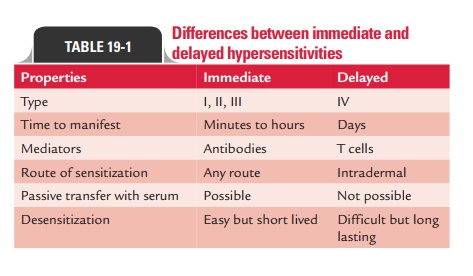Chapter: Microbiology and Immunology: Hypersensitivity
Hypersensitivity: Introduction
Hypersensitivity
Introduction
Hypersensitivity reaction denotes an immune response resulting in exaggerated or inappropriate reactions harmful to host. It is a harmful immune response in which tissue damage is induced by exaggerated or inappropriate immune responses in a sensitized individual on re-exposure to the same antigen. Both the humoral and cell-mediated arms of the immune response may participate in hypersensitivity reactions.
Hypersensitivity essentially has two components. First prim-ing dose (first dose) of antigen is essential, which is required to prime the immune system, followed by a shocking dose (second dose) of the same antigen that results in the injurious consequences.
Depending on the time taken for the reactions and the mechanisms that cause the tissue damage, hypersensitivity has been broadly classified into immediate type and delayed type. In the former, the response is seen within minutes or hours after exposure to the antigen and in the latter, the process takes days together to manifest as symptoms.
Prince of Monaco first observed the deleterious effects of jel-lyfish on bathers. Subsequently, Portier and Richet (1906) sug-gested a toxin to be responsible for these effects and coined the term “anaphylaxis”.
Gell and Coombs (1963) classified hypersensitivity reac-tions into four categories based on the time elapsed from expo-sure of antigen to the reaction and the arm of immune system involved. Types I, II, and III are antibody-mediated and are known asimmediate hypersensitivity reactions, while type IV is cell-mediated (i.e., mediated by cell-mediated immunity) and is known asdelayed hypersensitivity reactions.
Type V hypersensitivity reaction has been described later. It is called stimulatory type reaction and is a modification of type II hypersensitivity reaction.
Differences between immediate and delayed hypersensitivi-ties have been summarized in Table 19-1.

Related Topics